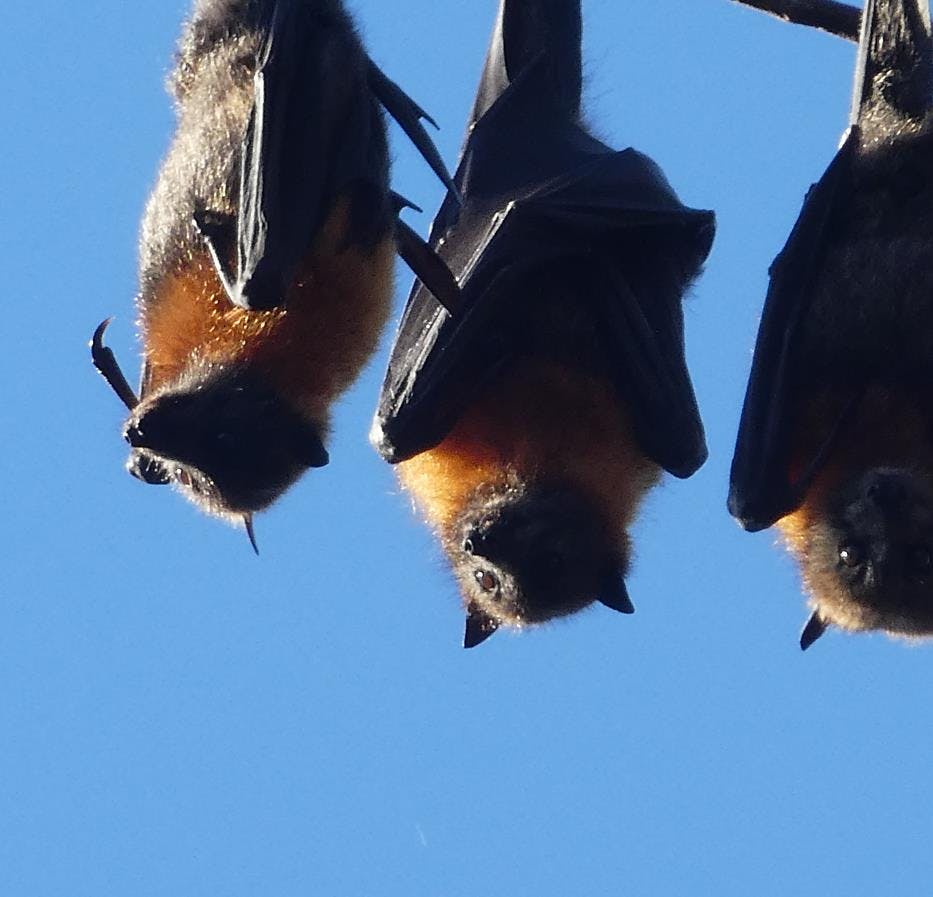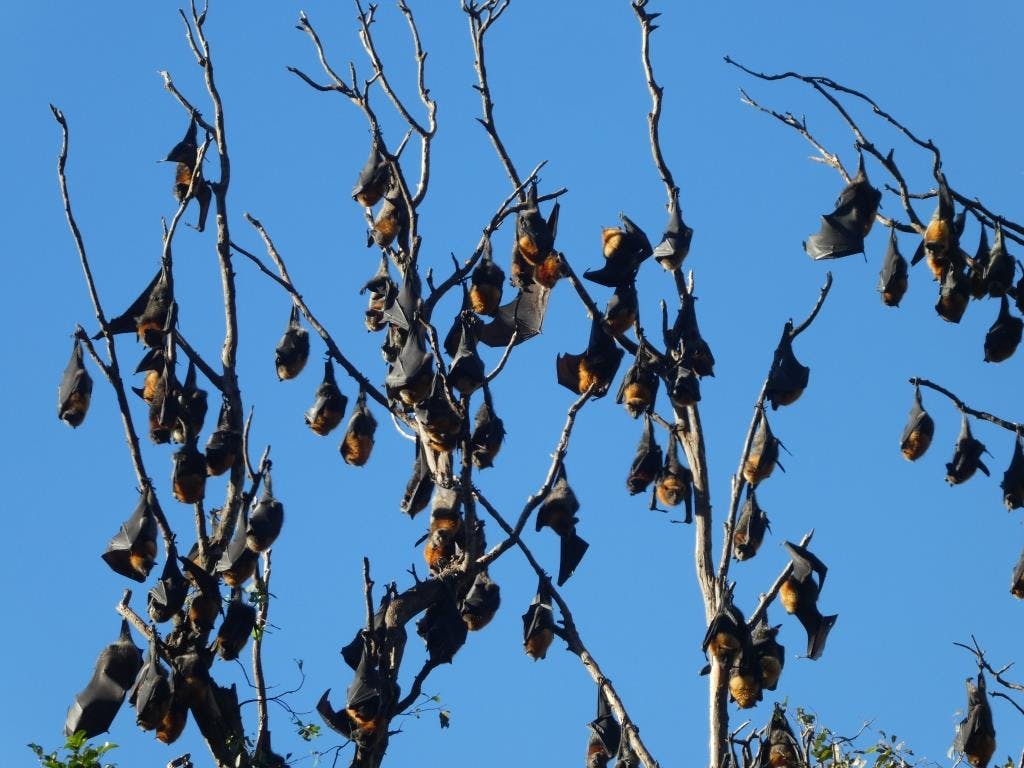Flying-foxes in the Clarence Valley
Clarence Valley Council is working to protect flying-foxes and their habitat and prevent negative interactions with flying-foxes in core habitats. To do this, we are developing a flying-fox management plan and communications strategy for the Clarence Valley, as well as working on habitat regeneration and revegetation in flying-fox habitats to increase buffers.
The Long Way Home's "Fly By Night stories from the Clarence Valley 2024" have been recorded, produced and published as a podcast series by 2GF. For more information or to listen to the podcasts, head to: https://2gf.au/articles/the-long-way-home-fly-by-night/
Clarence Valley Council is working to protect flying-foxes and their habitat and prevent negative interactions with flying-foxes in core habitats. To do this, we are developing a flying-fox management plan and communications strategy for the Clarence Valley, as well as working on habitat regeneration and revegetation in flying-fox habitats to increase buffers.
The Long Way Home's "Fly By Night stories from the Clarence Valley 2024" have been recorded, produced and published as a podcast series by 2GF. For more information or to listen to the podcasts, head to: https://2gf.au/articles/the-long-way-home-fly-by-night/
Q&A
Do you have a burning question about flying-foxes in the Clarence Valley? Ask us now!
-
Share We live near the high school. Previously they flew over us every night. Now they have mainly dispered from the school area and I want to understand where they have gone. on Facebook Share We live near the high school. Previously they flew over us every night. Now they have mainly dispered from the school area and I want to understand where they have gone. on Twitter Share We live near the high school. Previously they flew over us every night. Now they have mainly dispered from the school area and I want to understand where they have gone. on Linkedin Email We live near the high school. Previously they flew over us every night. Now they have mainly dispered from the school area and I want to understand where they have gone. link
We live near the high school. Previously they flew over us every night. Now they have mainly dispered from the school area and I want to understand where they have gone.
Clarence news update asked about 6 years agoHi, thanks for your question!
Flying-foxes are struggling at the moment to find enough food as a result of the drought and bushfires. As a result, many have been found deceased or acting unusually. You can read more about the north coast starvation event in our media release (https://www.clarenceconversations.com.au/flyingfoxes/news_feed/flying-foxes-fighting-for-food-after-bushfires). The starvation event could be one of the reasons why Maclean camp numbers are lower than normal.
Data from across the east coast suggests that starvation events and high heat events that result in the loss of large numbers of flying-foxes at a local level, don't have an ongoing impact on national numbers and the populations can recover quickly. The impact of the drought and bushfires this year has not yet been measured so time will tell. You can learn more about national numbers at the National Flying-fox Monitoring Viewer (http://www.environment.gov.au/webgis-framework/apps/ffc-wide/ffc-wide.jsf).
From historical events, we know that there can be a splintering of camps, with individuals moving elsewhere to access food resources. This can result in lower numbers at the main camps, so it could be that the flying-foxes that were consistently roosting in Maclean have also simply moved to other smaller camps or elsewhere outside of the Clarence Valley.
In addition, flying-foxes naturally move around in Australia over large distances. You can see the distribution of the species on the DPIE website (https://www.environment.nsw.gov.au/topics/animals-and-plants/native-animals/native-animal-facts/flying-foxes). Grey-headed flying-foxes are generally quite persistent at the Maclean camp. Black flying-foxes come and go but generally aren't around over winter, so should have returned just recently but numbers do seem to be lower than expected or arrival for the bulk of them is happening late. Little red flying-foxes are also not present at Maclean in winter and can generally can be seen in the Valley from late December to mid-March.
The Maclean flying-foxes used to spend significant amounts of time in the rainforest reserve and high school/TAFE, but now also use the gully more. Some individuals may have just moved up the gully, leaving fewer at the school.
So, apologies, but there's no clear answer. In summary, it could be a combination of the time of year and the widespread drought/fire issue resulting in lower numbers either at a local scale or overall. Time will tell.
Photos
Meet the Team
-
RL
Phone (02) 6641 7241 Email reece.luxton@clarence.nsw.gov.au
FAQ
- Why are flying-foxes integral parts of the ecosystem?
- Where can I find flying-foxes in the Clarence Valley?
- How can I tell the three local species of flying-fox apart?
- Why is the grey-headed flying-fox listed as a threatened species?
- What is a flying-fox management policy and plan?
- Why can't flying-fox camps be relocated?
- What can I do if flying-foxes are impacting my well-being?
- Who do you call in the Clarence if you find a sick or injured flying-fox?
- What do I do if I notice flying-foxes in heat distress?
- What do I do if I notice someone disturbing or harming flying-foxes?
- What do I do if I'm bitten or scratched by a flying-fox?
Learn More About Flying-foxes
- Clarence Valley Council: Maclean Flying-fox Management Strategy 2018 and Summary Fact Sheet
- A song about flying foxes
- NSW Government: Flying-foxes
- NSW Government: Flying-foxes of NSW
- NSW Government: Living with Flying-foxes
- NSW Government: Living With Grey-headed Flying-foxes
- NSW Government: Flying-fox Management
- NSW Government: Helping Flying-foxes in Emergencies
- CSIRO: National Flying-fox Monitoring Viewer
- NSW Government: Flying-foxes Health and Handling
- NSW Department of Primary Industries: Hendra virus
- SEQ Catchments: Flying-foxes of South East Queensland
- NSW Government: Flying-fox Camp Management Policy 2015
- Developing a Code of Practice Authorising Flying-fox Camp Management Actions
- Draft Code of Practice Authorising Flying-fox Camp Management Actions 2018
- ABC News: Some things you may not know about fantastic flying foxes
Document Library
-
 Flying-fox Camp Management Survey (574 KB) (pdf)
Flying-fox Camp Management Survey (574 KB) (pdf)
-
 Flying-fox Species Identification (961 KB) (pdf)
Flying-fox Species Identification (961 KB) (pdf)
-
 Flying-foxes in your Backyard Pamphlet (1.18 MB) (pdf)
Flying-foxes in your Backyard Pamphlet (1.18 MB) (pdf)
-
 Wildlife-friendly Netting Pamphlet.pdf (2.26 MB) (pdf)
Wildlife-friendly Netting Pamphlet.pdf (2.26 MB) (pdf)
-
 Fact sheet: Net it right, get it right (592 KB) (pdf)
Fact sheet: Net it right, get it right (592 KB) (pdf)
-
 Correct Disposal of Bats Guide (78.9 KB) (pdf)
Correct Disposal of Bats Guide (78.9 KB) (pdf)
-
 Flying-fox Safety Signage (1.89 MB) (pdf)
Flying-fox Safety Signage (1.89 MB) (pdf)
-
 Flying-fox Camp Management Survey Results (1.73 MB) (pdf)
Flying-fox Camp Management Survey Results (1.73 MB) (pdf)
-
 Community attitudes towards flying-foxes in the Clarence Valley Survey Results (451 KB) (pdf)
Community attitudes towards flying-foxes in the Clarence Valley Survey Results (451 KB) (pdf)


